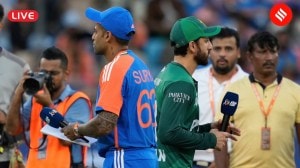Androids two NEW AVTARS
HTCs Hero has stunning looks while its Tattoo gives the option of customised styling
HTCs Hero has stunning looks while its Tattoo gives the option of customised styling
HTC HERO
With a curious-looking ‘chin’,backlit trackball and a crisp,bright touchscreen that covers roughly most of its surface area,the HTC Hero is undoubtedly a radical and stunning Android device. Unlike HTC’s Magic and G1,which had a very plasticky and cheap feel,the Hero is attractive and polished enough to give the iPhone a good competition. The device fits comfortably into ones palm. Its casing is made of a much-soft material,which adds to the entire experience of using the Hero. After a week of normal use,leaving it on the table,floor and car dashboard,I couldn’t detect a scratch.
The Hero is a home run when it comes to looks,though it’s not without issues. The 3.2-inch touchscreen with 320×480 resolution works well,but it does smudge despite an oleophobic or anti-finger print coating. One of my main gripes with the phone is that the buttons are pretty hard to press and placed inconveniently . The four across the top do not bother much,but the placement of the back key is a huge pain. It basically forces your hand into a cramp-inviting position.
When it comes to the software,HTC has given the Andriod a major makeover with its intuitive and customised interface called HTC Sense. It allows you to add glance view widgets that push content like Twitter feeds,weather etc. to the screen. And if you run out of screen space,there are six extra home screens you can swipe into view. Its like having seven desktops.
HTC Sense adds a slick,user-friendly layer that simplifies routine tasks like calling,e-mailing,texting and web-browsing,besides allowing normal gestures like touches,flicks and swipes. As in Blackberry phones,it also integrates your contacts list with Facebook,Twitter and Flickr,and shows,besides the callers’ name and number,their profile picture,status messages,albums shared etc.
Internally,the Hero is pretty much identical to the HTC Magic with the same Qualcomm 528 MHz processor,288 MB RAM and a paltry 512 MB ROM. However,its 5 megapixel camera is pretty good. Though the image quality isnt up there with dedicated point-and-shoots,its certainly much better than the nearest competitor with near-macro focus length. The battery life is pretty favourable with a talk time of upto 240 minutes. Overall,its a fantastic device and gets 4 out of 5.
Price: Rs 34,600 (Maharashtra); Rs 31,990 (Rest of India)
HTC TATTOO
If you wished to use an Andriod phone but were put off by the exorbitant prices,then HTC Tattoo is your solution. The Tattoo is targetted at the budget-conscious,young phone users who can now enjoy the Android experience by shelling out Rs 16,990.
Though an extremely compact phone,the Tattoo exteriors are pretty unassuming. And most striking of them is the four-way circular navigational button,which is undoubtedly sturdier than the trackball used by its predecessors.
The phone is all about individuality. HTC has released a number of funky cases with tattoo-like designs that help you customise back and front sides of the phone. You can flaunt your own style through your phones exterior,which is definitely more exciting than having a phone similar to others. However,unlike the Hero that sported a small camera lens despite its 5 megapixel count,the HTC Tattoos 3.2 megapixel camera lens,surrounded by a chunky metallic border,sticks out like a sore thumb. A big thumbs up for HTC for adding a 3.5mm headphone jack to this affordable Android.
Although its touch interface looks identical to that of the HTC Hero,the major difference is the screen: the Hero has a capacitive 3.2-inch HVGA while the Tattoo a resistive 2.8-inch QVGA. The Tattoos touchscreen is nowhere near as responsive as the Heros,and the quality of media playback on the Tattoo is also not as good. However,if you dont like the look of its interface,then the Tattoo has a great little option called Scenes,first found in the HTC Hero which helps you choose from a number of different skins,labelled as HTC,Social,Work,Play,Travel and Clean Slate. This is a fantastic way to re-skin your phones interface. Although it takes a while to re-skin (as it has to re-boot the operating system),it is a treat.
Web access is speedy with it taking just around seven seconds to load a non-image heavy webpage like Wikipedia. But once you are on the web,the problems with resistive screen soon appear. There is no pinch and zoom on and navigation requires that little added pressure while using the touchscreen. The Tattoo may not hold up against its own with the likes of HTC Hero,but for the price,sheer functionality and the ease of use,the Tattoo is a winner and gets 3 out of 5.
Overpriced for nothing
SONY ERICSSON YARI
The party is over but Sony Ericsson insists that it is still on with its Yari,which has been touted as a pure gaming device. However,there is nothing new about its pre-installed games which have been used and re-used. Also,there is nothing remarkable about this plasticky-looking slider phone with a bright 2.4-inch screen. The 5 megapixel camera is robust,complete with flash,4x digital zoom and smile and face detection. The phone comes with a 1 GB memory card and it can be expanded up to 16 GB. These are all standard features from any mid-level phone,exactly what the Yari wishes not to be.
But turning to what makes this phone different is where the problems start. The motion-controlled games are remarkably vague,relying more on blind luck than skill. Random strokes produced better results than reasoned strokes in the bundled tennis game. Only Loco Roco,a mobile port of Sonys famous PSP title,proves a saving grace. Getting a call or a message in between a gaming session,for instance,freezes the phone for a few seconds. At Rs 16,950,you are paying a premium for this mid-range phone.
Photos



- 01
- 02
- 03
- 04
- 05




























